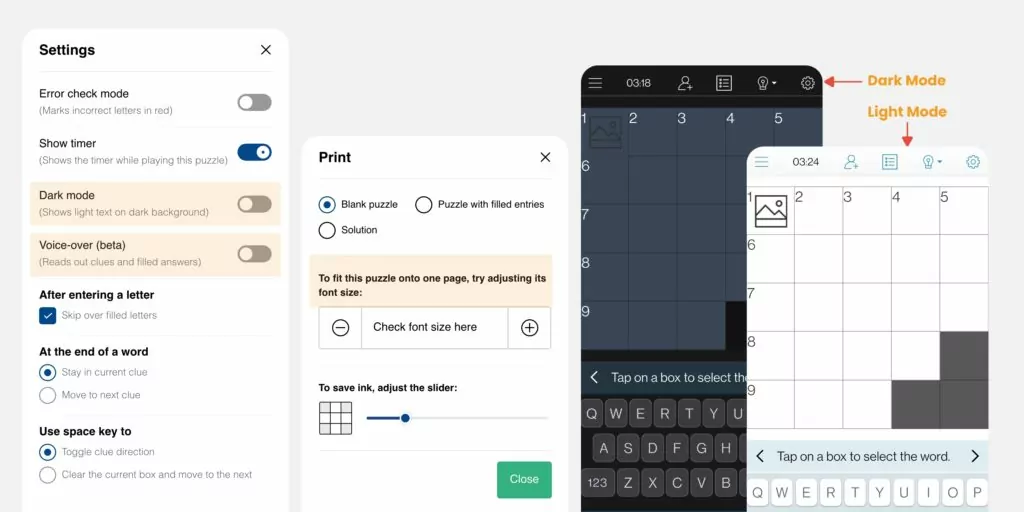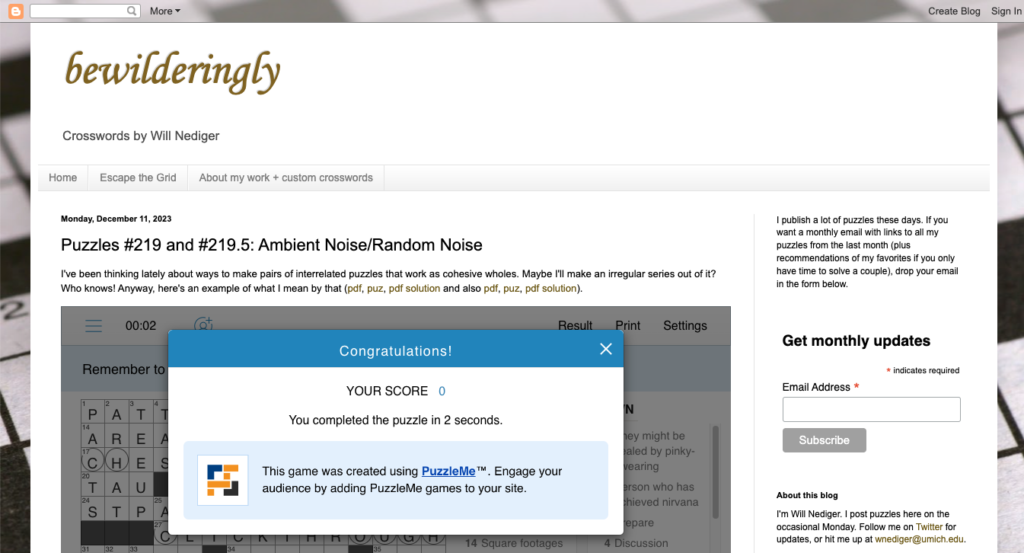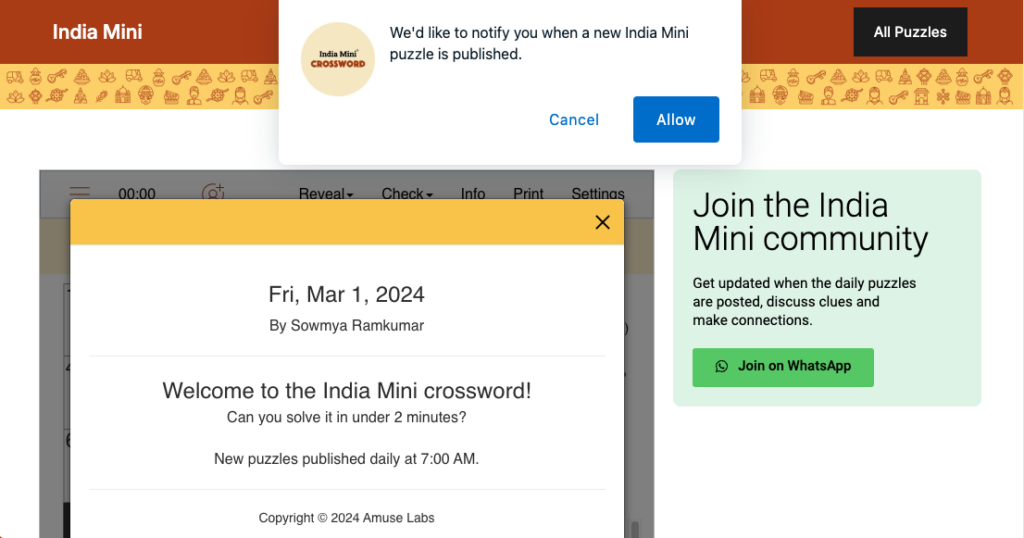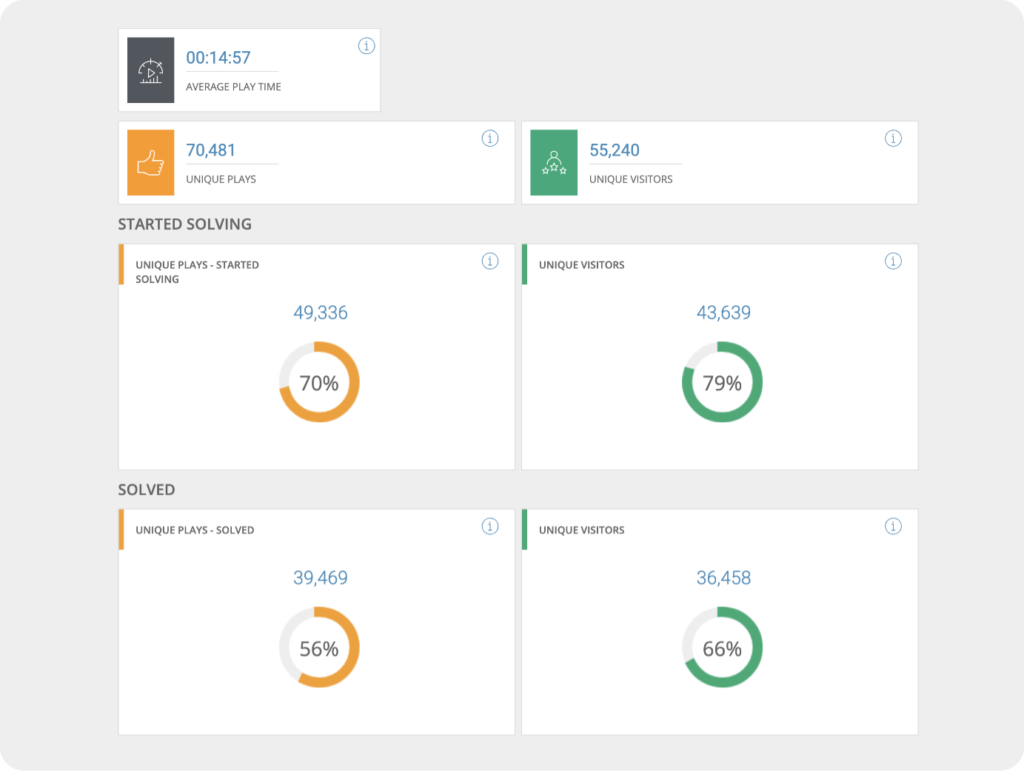Are you thinking of finally starting your crossword puzzle blog? Whether you’re a new constructor or would just like editorial freedom over your puzzles, a blog is a great way to publish in a low-pressure environment.
I’m Nishant, and I recently set up the India Mini crossword blog on WordPress. In the process, I encountered many challenges and discovered interesting things about starting a crossword puzzle blog. In this guide, I’m sharing some learnings from the experience.
Why Start a Crossword Puzzle Blog?
This is the first question you should answer: what am I looking for with a crossword puzzle blog? Starting a crossword puzzle blog can serve multiple purposes. It can be a platform for sharing your passion, a community hub for fellow enthusiasts, and even a source of income through subscriptions, advertising, and partnerships. Every decision henceforth will be based on your goals. For example:
- If it’s a hobby, it would be best to choose free options for a blogging platform and a tool for creating your crosswords. Design and statistics also won’t matter to you that much. You could set up such a blog relatively quickly.
- If it’s a venture, or could potentially be one in the future, you might want to publish ads or sell subscriptions to your crosswords. This is where the choice of platforms and design decisions end up mattering quite a bit.
So start by deciding what you want out of the project.
Finding Your Niche
The next step in starting your crossword blog is to find your unique angle. The world doesn’t need another generic set of puzzles, and you might have trouble getting traction for your blog without the right niche.
Thankfully, the crossword community is diverse, with interests ranging from casual puzzles to cryptic challenges. Your blog could focus on a particular type of crossword, such as American-style, cryptic, or thematic puzzles. Alternatively, you could cater to a specific skill level, from beginners to advanced solvers.
With the India Mini crosswords, for example, I set up a blog only for solvers who are aware of the Indian context. Find the niche you’d like to cater to and get started.
Setting Up Your Blog
1. Choose a Crossword Platform
Start by choosing a platform to construct and publish your puzzles. We, of course, recommend PuzzleMe here. (Full disclosure: We are the creators of PuzzleMe). It’s the most powerful crossword puzzle maker and offers a polished experience for your solvers. The best part is that it’s entirely free for non-commercial users. If you’re doing this as a hobby, it’s a great option to consider.
Revered crossword constructors like Will Nediger, Paolo Pasco and Mangesh Ghogre use PuzzleMe to add crosswords to their blog. Check out a list of popular constructors and links to their blogs here.
2. Set Up a Blog
There are several blogging platforms to choose from, such as WordPress, Blogspot, Wix, and Squarespace. Each offers various customization options and ease of use. Keep in mind, though, that the free WordPress.com plan does not allow iframe embeds.
For the India Mini, we used a combination of a paid WordPress plan and Elementor to build the site.
If you’d like to create a free blog without much hassle, Blogger is a great option. The benefit of using Blogger is that you could publish your writing, have a nice About page, and add your crosswords to the same website. Will Nediger’s crossword blog runs on Blogger. You can see what that looks like here.
Design and User Experience
Your blog’s design should be clean and navigable, ensuring that visitors can easily find and solve puzzles. Thankfully, PuzzleMe takes care of this to a large extent for you. If you have any trouble embedding your puzzles into your blog, you can get in touch with us at support@amuselabs.com.
Content Creation
Content is king in the blogging world. For a crossword blog, this means a steady stream of puzzles. You can create puzzles yourself using PuzzleMe. Magic Fill in particular is a feature that’s useful for building mini-puzzles. All you have to do is select the size of your grid and the words you would like included, and Magic Fill will find possible fill options for your puzzle.
Building an Audience
SEO and Keywords
To attract visitors, your blog needs to be visible on search engines. Research keywords related to crosswords and incorporate them into your blog posts, titles, and meta descriptions.
For the India Mini crossword, the important keywords include ‘small crosswords’ and ‘Indian crosswords’ among others. You can learn how to use Google’s keyword planner to find relevant keywords for your niche.
Social Media and Community Engagement
Leverage social media platforms like Twitter and LinkedIn to share your content and engage with the crossword community. Join crossword forums and groups to participate in discussions and promote your blog.
By default, PuzzleMe nudges your solvers to post their results on social media. When they do, you can interact with their posts to boost visibility.
Email Marketing
An email newsletter can be a powerful tool for building a loyal readership. Collect email addresses from your visitors to keep them informed about new puzzles and posts.If you’re using PuzzleMe, it’s easy to collect names and email addresses at the start of your puzzle. See the video guide to set this up here:
Push Notifications
Another great way of reaching your solvers is through push notifications. For this, you can use a service like OneSignal. Follow the instructions on their website to add OneSignal to your website, and it’ll start prompting your solvers to sign up for notifications.
Once you have a significant number of sign-ups, you can send a push notification each time you publish a new puzzle. The best part is that this doesn’t require collecting any information regarding your solvers.
Monetizing Your Blog
Once you have a steady flow of traffic, you can explore monetization options. These can include:
- Advertising: Display ads on your blog through networks like Google AdSense. Keep in mind that this requires scale, as most ad programs require that you have at least 50,000 visitors over the past month to qualify to run ads.
- Affiliate Marketing: Partner with puzzle book publishers or apps and earn commissions on sales. Mangesh Ghogre, for example, uses the puzzles on his website to promote his crossword book.
- Subscriptions: Offer premium content or ad-free solving experiences for a subscription fee. Plenty of such options have emerged, like The Puzzle Society.
- Merchandise: Sell crossword-themed merchandise such as mugs, t-shirts, and books. You can include links to the content you’d like to sell in the end-message of your puzzle.
Track your analytics
With PuzzleMe, you get a lot of useful data about your solvers. You get to know what percentage of them completed a puzzle, how many times your puzzle was played, and even a heatmap of how difficult solvers found your clues.
Conclusion
Starting a crossword puzzle blog is an exciting journey that blends creativity, community, and technology. You can turn your love of crosswords into a thriving online hub by offering engaging content, a user-friendly experience, and a personal touch.
Remember, the key to a successful blog is passion. If you love what you’re doing, it will shine through in your content, and your audience will grow. So, set up your domain, create your crossword puzzle, and step into the world of crossword blogging. Happy puzzling!
- Wausau Pilot Monetizes Games with Local Sponsors - July 7, 2025
- 🧩 A New Take on Spelling Bee - June 17, 2025
- Natan Last Documents the Past, Present and Future of Crosswords - May 27, 2025




